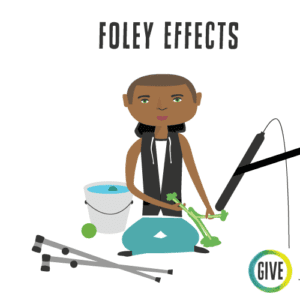Making Foley Sounds
Contribution de Laura Borgwardt
![]()
![]()
Description
This activity helps students discover how the sounds used in movies and animations are created behind the scenes, by practicing making sounds with various objects and matching them with the actors’ actions and moods. Students will have a chance to become actors, Foley artists, and audience members, working in collaboration to build a positive community in the classroom.
instructions
- Introduce the class to Foley—Foley effects are the sounds that are added to a movie or a play. They help increase the sound quality and help tell a specific story.

- Have students explore different Foley objects—what sounds do they make?
- “Today we are going to make the sounds of different characters moving across the stage. Some characters might be realistic and their footsteps might sound like shoes walking on the floor; some characters might be silly and their footsteps sound a little wacky (e.g., the SpongeBob SquarePants walking noise); and some characters might slither or crawl across the space.”
- Have one actor (maybe a Classroom Professional) move across the stage/space/screen in a specific way. “How did the actor move? Were their movements small/big? Light/heavy? Realistic/silly? Does anyone have a sound effect that matches that character?”
- The actor will cross the space again, this time with the Foley artist matching their movements with sound. “Make sure to pay attention—the sound should happen at the exact moment their foot or other body part hits the floor.”
- Try working backward! Have one of your Foley artists play a sound and have that sound inspire the actor to create a way of moving that matches the Foley.
- Réflexion:
- “Did you like being an actor or a Foley artist better? Why?”
- “What were the important skills we needed in each of the roles?”
- Extensions: You could have a puppet move across the space and match their footsteps, or have the actor “walk” with different parts of their body (e.g., fingers, elbows, etc.).
Transition Into Activity
Entrez dans l'espace avec un couineur caché ou un autre objet Foley dans votre main et faites correspondre vos pas avec le couineur. Agissez de manière très confuse et demandez à la classe s'ils entendent ce bruit. Découvrez votre objet Foley.
Transition Out of Activity
“What Foley sound could we use for someone falling asleep/snoring? Let’s all try. Relax. Sleep. Okay, wake up! (Bringggggg!) It’s time to get back to class.”
Aménagement de la salle de classe
Audience/playing space.
Supports/Matériaux adaptatifs/Outils
- For those with sound sensitivities, you can have headphones available to wear during the game or find a seat for them that is further from the Foley artists.
- Have lots of different kinds of Foley that are manipulated in different ways—squeeze, hit, scrunch, slap. Have options that require both fine motor and gross motor skills.
- Si vous êtes vraiment chic et avez un microphone, placez le microphone par les artistes Foley afin qu'ils puissent utiliser un plus large éventail d'objets pour faire les effets sonores.
- Visual Vocabulary Cards (downloadable).
- Video examples to learn about Foley sounds:
Rôles possibles pour les professionnels de la classe
- Model 100% participation—encourage a Classroom Professional to volunteer to be the first actor and invite them to be as silly as they can. Their willingness to take a risk will encourage the students to do so as well.
- Side-coach Foley artists: “Got your object ready? Okay, they are taking the first step—squeeze!”
Adjustments for Remote Instruction
![]()
C'est un bon jeu pour les cours en ligne où certains étudiants veulent allumer leur caméra (ils peuvent être des acteurs !) Préparez-vous en classe avec quelques exemples d'objets que les élèves peuvent avoir chez eux pour créer du son. L'acteur devra s'assurer que la plus grande partie de son corps est dans le cadre, surtout s'il traverse son espace. Assurez-vous que tous les membres du public sont en sourdine afin que l'artiste Foley puisse être entendu.
